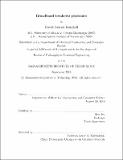Broadband terahertz photonics
Author(s)
Burghoff, David Patrick
DownloadFull printable version (4.513Mb)
Other Contributors
Massachusetts Institute of Technology. Department of Electrical Engineering and Computer Science.
Advisor
Qing Hu.
Terms of use
Metadata
Show full item recordAbstract
In recent years, quantum cascade lasers have emerged as mature semiconductor sources of light in the terahertz range, the frequency range spanning 1 to 10 THz. Though technological development has pushed their operating temperatures up to 200 Kelvin and their power levels up to Watt-level, they have remained unsuitable for many applications as a result of their narrow spectral coverage. In particular, spectroscopic and tomographic applications require sources that are both powerful and broadband. Having said that, there is no fundamental reason why quantum cascade lasers should be restricted to narrowband outputs. In fact, they possess gain spectra that are intrinsically broad, and beyond that can even be tailored to cover an octave-spanning range. This thesis explores the development of broadband sources of terahertz radiation based on quantum cascade lasers (QCLs). The chief way this is done is through the development of compact frequency combs based on THz QCLs, which are able to continuously generate milliwatt levels of terahertz power covering a fractional bandwidth of 14% of their center frequency. These devices operate on principles similar to microresonator-based frequency combs, and make use of the quantum cascade laser's fundamentally large nonlinearity to phase-lock the cavity modes. These devices will enable the development of ultra-compact dual comb spectrometers based on QCLs, and will potentially even act as complete terahertz spectrometers on a chip. This thesis also uses broadband terahertz time-domain spectroscopy to analyze the behavior of THz QCLs. By using QCLs as photoconductive switches, the usual limitations imposed by optical coupling are circumvented, and properties of the laser previously inaccessible can be directly observed. These properties include the gain and absorption of the laser gain medium, the populations of the laser's subbands, and properties of the waveguide like its loss and dispersion. Knowledge of these properties were used to guide frequency comb design, and were also used to inform simulations for designing better lasers.
Description
Thesis: Ph. D., Massachusetts Institute of Technology, Department of Electrical Engineering and Computer Science, 2014. This electronic version was submitted by the student author. The certified thesis is available in the Institute Archives and Special Collections. Cataloged from student-submitted PDF version of thesis. Includes bibliographical references (pages 181-190).
Date issued
2014Department
Massachusetts Institute of Technology. Department of Electrical Engineering and Computer SciencePublisher
Massachusetts Institute of Technology
Keywords
Electrical Engineering and Computer Science.